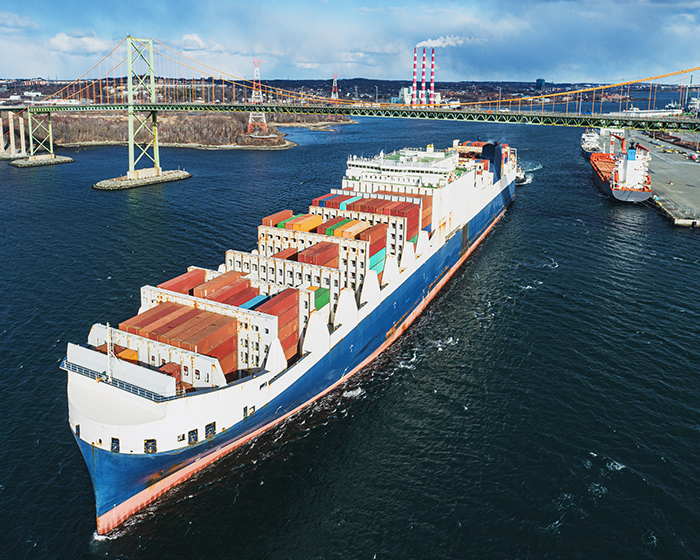Inbound logistics is a critical aspect of supply chain management that involves the processes and operations responsible for coordinating incoming goods and materials. It’s essential for supply chain professionals to understand the intricacies of inbound logistics to ensure efficient inventory management, ongoing cost reduction and continued customer satisfaction. Here, we will explore the meaning of inbound logistics and the key components that make it work while providing valuable insight that will help you optimize your supply chain operations.
Inbound logistics deals with all the activities that orchestrate the receipt of goods, materials and supplies into a business’s supply chain, including receiving, storing and distributing. According to the ASCM Supply Chain Dictionary, inbound logistics is defined as the group in charge of moving materials from suppliers or vendors into production processes or storage facilities and the actual movement of such material.

Implementing and running an efficient inbound logistics system is extremely important for the success of a company’s operations. Securing optimal levels of raw materials and stock ensures a smooth supply of products to meet customer demand without suffering the revenue loss of wasted goods or storage space. Proper warehousing and prompt delivery protect the quality of your product and brand, building and maintaining customer satisfaction.
Internally, efficient, streamlined inbound logistics keep your operations running smoothly and avoid putting undue pressure or stress on your employees. A well-run work environment contributes greatly to job satisfaction.

There are many components that make up the inbound logistics process, each dependent on the successful execution of the other. The key components include:
Coordinating and maintaining supplier relationships and managing the flow of goods from suppliers to the company’s warehouses or production facilities.
Planning, executing and optimizing the physical movement of goods. This is usually done through centralized software and cross docking logistics technology, which allow companies to accurately automate and track all product movement and implement effective transloading.
Ordering and tracking supplies and stock as they arrive in your warehouse or production facilities, usually done through inventory management software systems.
Transporting raw materials, products under manufacture and finished products to different locations within a facility.
Systematically reviewing each process within the inbound logistics system to check for any weaknesses or bottlenecks and discover opportunities for improvements.
Unloading incoming supplies to check for damage, log inventory, allocate storage space and notify accounts payable of receipt.
Successful companies constantly look for ways to gain efficiencies, improve customer service and increase revenue by improving existing operations. These are some of the ways your organization can optimize your inbound logistics processes:
Collaboration: Collaborating with suppliers and partners within your supply chain by sharing information and aligning schedules will help you synchronize deliveries, reduce lead times and enhance overall supply chain visibility, resulting in improved inventory management and more accurate forecasting.
Transportation consolidation: By combining shipments from multiple suppliers, you can reduce transportation and freight costs, reduce the number of trips and subsequently minimize your environmental footprint by cutting down on fuel consumption and emissions.
Just-in-time inventory management: Utilizing the proper software systems and implementing reliable communication and coordination with your suppliers will allow you to schedule and control inventory more accurately to successfully meet demand. The results? A reduction of inventory waste and superfluous warehouse storage costs.

Because of the complexity of coordinating schedules, inventory and transportation, properly running an inbound logistics operation can present organizations with some significant challenges. Here, we’ll discuss some of the common challenges you may experience and potential solutions to help you overcome them:
Challenge: If your suppliers are unable to consistently deliver quality products on time, the disruptions to your supply chain will ramp up costs and possibly damage your reputation.
Solution: It’s important to build strong relationships with your suppliers through open communication and collaboration. Be sure they know what you expect of them by providing them with Key Performance Indicators (KPIs) that will help you regularly track their performance. It’s also a good idea to build a network of suppliers so you’re not solely dependent on just one or two.

Challenge: : Poor inventory management can leave you with gaps in supply or costly overages and waste.
Solution: Implementing advanced inventory management software solutions and robust demand forecasting techniques will help you accurately track, manage and predict stock levels and be prepared for future fluctuations. In addition, adopting just-in-time inventory management will help reduce excess inventory and minimize holding costs.

Challenge: High transportation and logistics costs can significantly impact the overall cost efficiency of your supply chain.
Solution: Utilizing optimization software helps you find the most efficient routes to help reduce fuel costs and expedite delivery times. By consolidating your shipments, you’ll be able to take advantage of bulk shipping rates. And you may want to consider partnering with a 3PL provider –– due to their expertise and ability to scale, they may be able to offer you additional cost efficiencies.

Challenge: Navigating the complex landscape of international trade regulations, customs requirements and environmental standards can be stressful, time-consuming and costly, if you make a mistake.
Solution: It’s important to keep your employees well-trained and up to date on the latest rules and regulations. There are some supply chain compliance software systems that can help you avoid compliance problems before they become an issue. You may even wish to engage with a consultancy service if you can’t invest in in-house expertise.

Accurately implementing a successful inbound logistics program will benefit your supply chain in numerous ways:
While inbound logistics focuses on the transportation, storage and receiving of goods and materials from suppliers to your company’s warehouse or production facilities, outbound logistics manages the distribution of finished products from your company to the end user. It’s important that both of these functions work together to achieve streamlined operations within your supply chain and ensure the ultimate goal of customer satisfaction.
The following links provide more in-depth information on other supply chain topics:
Subscribe today and you’ll receive valuable supply chain insights from the top leaders in the industry that will help you do your job better, faster, and more efficiently. From industry news to insider tips and trends, Signals delivers a quick read on the latest information on supply chain management right to your inbox.
